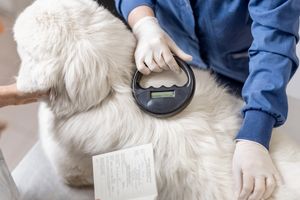May is Chip Your Pet Month, so it’s a perfect time to learn more about dog and cat microchipping. Sometimes, our furry family members wander further than they should or run away because of fear or stress. When this happens, microchipped pets are more likely to find their way home. Having your pet chipped boosts your odds of reuniting with them if someone steals them. With an estimated one in three pets getting lost or stolen during their life, we strongly recommend having your four-legged family member microchipped. In this blog post, we’ll be discussing this simple, life-saving procedure and how it can protect your pet.
What Is Microchipping?
Cat and dog microchipping is a relatively affordable and minimally invasive procedure that provides pets with permanent identification. Unlike a tattoo that can become illegible or a tag that can get lost, a microchip stays in place and remains functional throughout your pet’s entire life.
We use a syringe to inject a tiny computer chip into the area between the patient’s shoulder blades during the procedure.
Some other things you should know about pet microchips and the microchipping procedure are:
- The chip is about the same size as a grain of rice.
- The entire process takes just a few moments and feels similar to receiving a vaccination.
- There is no need for sedation or anesthetic, and your pet can resume their normal daily activities as soon as they leave the office.
During your pet’s appointment, we will help you register their microchip. Every chip has a unique identification number linked to an online account. Once registered, this account contains vital information, including your pet’s name, your name, phone number, etc. Make sure to update this account if you move or get a new phone number. Your pet’s rescuer can only reach you if they have accurate contact information.
How Microchipping Protects Your Pet
If someone finds your dog or cat and takes them to a shelter or veterinary practice, an employee will use a special scanner to check for a microchip. The scanner displays the microchip’s ID number, and the worker uses that number to trace your pet back to you. While there is no foolproof means of ensuring that you’ll see your pet again if they ever get lost, having them microchipped significantly improves the odds.
A microchip is also a powerful tool for proving that you own your pet if they ever fall into the wrong hands. Investigators can check stolen pets’ chips to determine ownership and prove theft.

Can a Microchip Fall Out?
One concern that pops up frequently among pet parents is whether a microchip can fall out. Microchips last a pet’s entire lifetime. A properly implanted chip cannot fall out or become damaged. Once inserted and registered, the only thing you need to do is update your account if your contact information changes.
However, in rare instances, a microchip can migrate. The chip will end up somewhere other than its original location in your pet’s body when this happens. For this reason, we recommend asking us to scan your pet during their annual checkup. This allows us to ensure the microchip is still positioned correctly and functioning. Veterinary professionals are trained to scan the pet’s entire body looking for a microchip, not just the classic location between the shoulder blades. Even if the chip has migrated, the scanner will sense it.
Are There Any Downsides to Microchipping?
There are no real downsides associated with microchipping. The process is relatively painless, and complications are extremely rare. Your pet most likely will not experience any irritation or discomfort. They probably won’t even know the chip is there!
The only potential drawback is that this form of identification only works when a lost pet makes their way to someone with a scanner. Fortunately, nearly every animal shelter, veterinary hospital, and humane society have a scanner. Most animal control facilities and police stations have scanners, too. As long as your pet’s rescuer takes them to someone with a scanner, you won’t have any issues.
If an individual finds your pet and doesn’t take them somewhere with a scanner, they will be unable to identify them using their microchip. We recommend keeping a collar with identification tags on your furry friend at all times for this reason. It’s always a good idea to make sure your pet has a form of backup identification.
Having Your Pet Microchipped for Chip Your Pet Month
The AVMA also has an excellent Pet Microchip FAQ resource. There’s no better way to celebrate Chip Your Pet Month than having your companion microchipped. The benefits greatly outweigh the extremely low risk of complications, and taking just a few minutes to have your pet chipped could save their life. Call us today to find out more or schedule your pet’s appointment!

